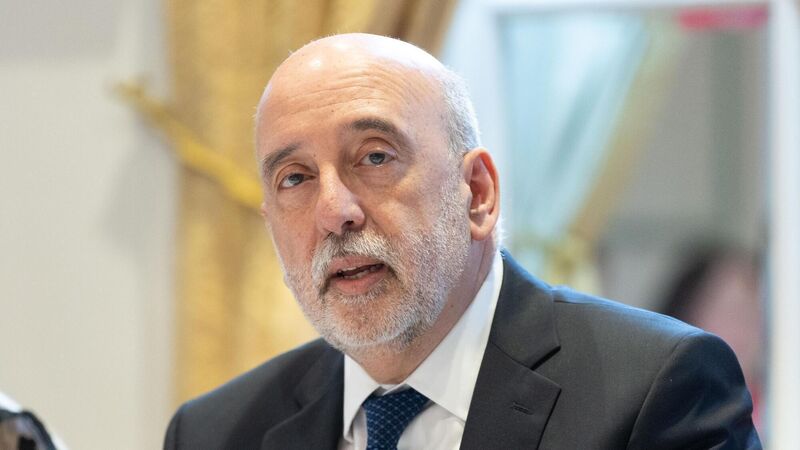Finances of many households remain fragile with the impact of rate hikes yet to be fully felt

Gabriel Makhlouf, Governor, Central Bank of Ireland. 'The Bank’s renewed emphasis on properly assessing borrower capacity will be critical in 2024'.
Many who have been out and about in the run-up to Christmas this year have agreed on one thing; we are living in the era of ‘this month’s price’.
With so-called ‘discretionary spending’ – a luxury available to too few – it is especially noticeable. Restaurants, pubs, retail outlets, gigs and shows all seem so expensive, though a plastic card helps to disguise the extent of the damage.
Recent information from the Central Statistics Office (CSO) on cost of living increases seems to support this. It suggests that the categories with some of the largest price increases in the 12 months from October 2022 to October 2023 were Recreation & Culture (+9.7%), Restaurants & Hotels (+7.7%) and Food & Non-Alcoholic Beverages (+7.0%).
The cost of rent, mortgage interest repayments and energy have also continued to put households under major financial pressure over the year, with the category of ‘Housing, Water, Electricity, Gas & Other Fuels’ seeing a 7.2% increase between October 2022 and October 2023. Over November 2023, this category decreased by 2%, some sign at least that energy costs are decreasing at last.
More generally, the Consumer Price Index (CPI) rose by 5.1% between October 2022 and October 2023. By way of comparison, the CSO also records that average weekly earnings in Q3 of 2023 were €907.72, an increase of 4.6% from €867.63 in Q3 2022, an indication that wages are not keeping pace with cost of living increases.
So much for figures, which can only reflect the reality of people’s lives in a limited way. For those on low to moderate incomes, staying solvent is an uphill struggle and a constant worry and the effect of monetary and economic policy, implemented in principle to protect our interests, can sometimes seem more than uneven in its effect.
Thus, recent European Central Bank (ECB) policy has been to increase interest rates to drive down demand and reduce the rate of inflation by limiting the amount of money circulating through the EU economy. With higher interest rates, there should in theory be a lower demand for goods and services, and the price for those goods and services should eventually fall. However, factors such as the major spike in energy costs internationally (now starting to even out) and the spending of some of the savings accumulated by some households throughout covid 19, means that progress on this objective seems to have been relatively slow, as the price increases that continued to occur in 2023 outlined above indicate.
With rising interest rates, the cost for borrowers of servicing new and existing consumer credit agreements – mortgages, personal loans, hire purchase and credit card agreements, credit sales and buy now, pay later agreements – also increases, particularly where the interest rate on such agreements is variable. This potentially undermines much of the good that price stability achieves. If prices do not stabilise or fall while interest rates rise, many households come under greater not less financial pressure. For those without accumulated savings to act as a buffer, that generally means increased consumer over-indebtedness.
Recent research published by the Central Bank of Ireland (CBI) - ‘Debt service capacity across Irish borrowers: New survey evidence’ (Singh and Yao, 2023) - gives us some insight into where this potentially leaves households in financial terms as 2023 comes to an end. Based on a weighted sample of 1,200 respondents in September 2023, approximately 30% of whom were mortgage borrowers and 70% non-mortgage borrowers, this piece assesses the room for manoeuvre in the finances of households across a range of factors. These include current savings flow; debt servicing history; pandemic savings; financial buffers, and potential responses to future cost of living increases.
- The findings of this research include the following:
- Around one-third of the sample had zero savings flow.
- Around one in five missed one (or more) payment(s) on a utility bill, a loan (consumer credit), or a housing payment (rent or mortgage) in the previous 12 months.
- Just over a half had no savings in excess of their normal savings flows during the covid-19 period.
- Over two-thirds of those who missed a housing payment and 85% of those who missed a loan payment over the period had no savings in excess of their normal savings during Covid.
- Around one in four have no financial buffer to service debts in the event of future income loss.
- Around one in five said that either missing payments or new borrowings would be their likely response to future cost of living increases.
Of course, this is only a sample, but it firmly emphasises the fragility of household finances for some in an economy and society where credit is a constant and economic growth is reliant on consumer borrowing to a significant extent.
It is useful to see the Central Bank engage in such borrower-focused research and this is evidence of a more pro-active approach to monitoring problem debt. For too long, there has been a tendency to blame the borrower in financial difficulty for poor management of money when limited housing options, low income and limited access to affordable credit, are underlying contributors. Equally, it is helpful to see an increasing recognition that, in the main, debt problems occur because of payment capacity issues brought on by life events outside the borrower’s direct control – recession, illness, separation and loss of work or business – and not by choice on the borrower’s part.
The Central Bank’s renewed emphasis on properly assessing borrower capacity and ensuring that regulated entities are closely supervised in terms of facilitating affordable repayments and adherence to regulatory codes will be critical in 2024. The effect of increased ECB interest rates has not fully fed into the financial system as yet and there are also likely to be a number of mortgage borrowers whose fixed rate options will come to an end in the year to come.
While 2023 may have been a year in which regulatory awareness has improved, it has not been a good year for law reform in the resolution of over-indebtedness. The long-awaited statutory review of the Personal Insolvency Act 2012 remains to be completed and no explanation has to date been provided for this delay. There are notable deficiencies in the legislation as it currently stands. For example, it fails to provide sufficient enforceable options for insolvent borrowers with unsecured debt only to write down their debt. It also fails to provide effective resolution mechanisms for the sizeable number of borrowers in mortgage arrears or restructure facing an income shortfall in retirement.
- Paul Joyce is Senior Policy Analyst with Free Legal Advice Centres (FLAC)











